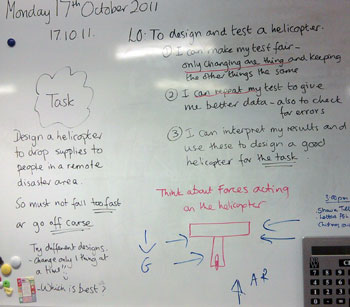Copyright © University of Cambridge. All rights reserved.
'Helicopters' printed from https://nrich.maths.org/
Show menu

Why work on this activity?
This activity offers an opportunity to combine skills from mathematics, science and technology. Students are required to consider different options, experiment with variables, keep records of results, make predictions, analyse and present data, develop convincing arguments, work collaboratively, and work within constraints.
Possible approach
Using this template, give everyone in the class the chance to make a helicopter and try it out. You may wish to show the video first.
Next, introduce the challenge to design the "best" helicopter. You might like to set the parameters for "best" yourself, or to have a class discussion on suitable criteria for judging helicopters. This should include a decision on the height from which the helicopter will be dropped, as well as the load it will carry.
Arrange students in small groups, and make it clear that at the end of the time available they will need to present to the rest of the class their helicopter with supporting evidence of its merits.
To round off the activity, allow plenty of time for each group to present their design and encourage the rest of the class to give positive feedback and also to comment on how (un)convinced they are by the evidence presented in the "sales pitch".
Equipment:
- helicopter template (perhaps printed on thin card)
- paper and card of different thicknesses
- paper clips
- scissors
- ruler
- sharp pencil
Key questions
What's the maximum number of paper clips you can add while still having a safe descent and landing?
Does the helicopter always land in the same place?
Can you make it fly to particular places?
Does it always rotate in the same direction?
Possible extension
This activity could be extended in a couple of ways: firstly by introducing more demanding success criteria for the helicopter, or secondly by expecting a more rigorous analysis of the results from the tests done with different helicopters.
Possible support
Remind students to keep everything constant except that which they are testing, and to perform each experiment more than once and take average results.
Guidance could be offered on the sorts of changes to make, for example, keeping the helicopter in the same proportions, but gradually increasing its overall size, or keeping the width of the wings and the body constant, and gradually increasing the length of the wings and body.